Survey uncovers the biggest challenges holding your teams back, including app and meeting overload

Interact with more than 10 people in a day
Survey uncovers the biggest challenges holding your teams back, including app and meeting overload

Collaboration plays a big role in an organization’s ability to get things done. You might rely on colleagues within your own department or across different functions in the organization to brainstorm new ideas, make decisions, execute plans, and complete projects large and small.
But collaboration in today’s world isn’t as straightforward as it once was when everyone was working in the same office space. Now teams are more likely to work in hybrid environments with a mixture of remote and in-office colleagues. Organizations are also more likely to have multiple generations of workers under one roof, each with their own distinct ways of communicating.
At Zoom, we sought to understand how teams are collaborating today, the challenges they face, and what they feel they need to do their best work in a business environment that’s more complex than ever. Our Global Collaboration in the Workplace report, based on an online survey commissioned by Zoom and conducted by Morning Consult, looks at the experiences of nearly 8,000 leaders and employees in 16 countries, the impact of the apps and tools they use, generational differences in how they prefer to work, and how all these factors affect collaboration and productivity.
Here are a few key findings:
Organizations pay for bad collaboration through wasted time and disengaged employees, and each has associated costs. Addressing some of the issues that lead to bad collaboration could help leaders and employees be more effective with their time and more satisfied with the results of their teamwork.
*Calculations per manager are estimates based on average salary information for management occupations as provided by the U.S. Bureau of Labor Statistics. Total cost is based on APQC data regarding the average number of managers in an organization.
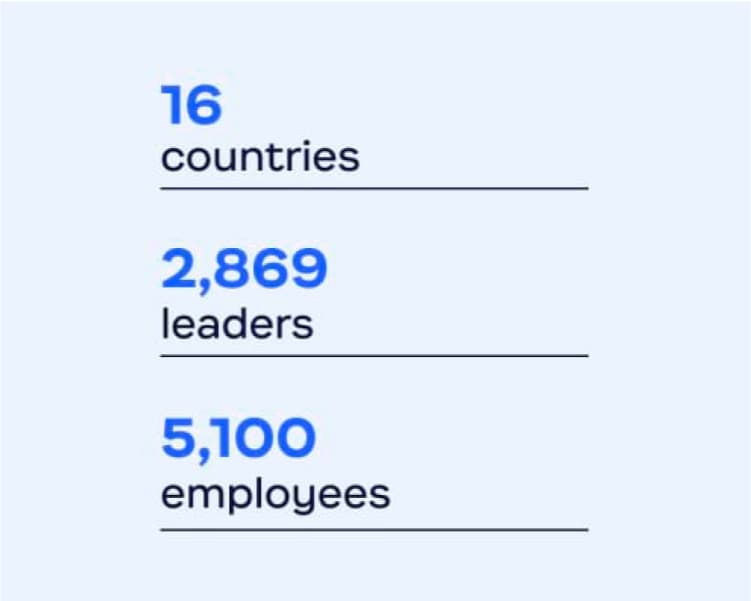

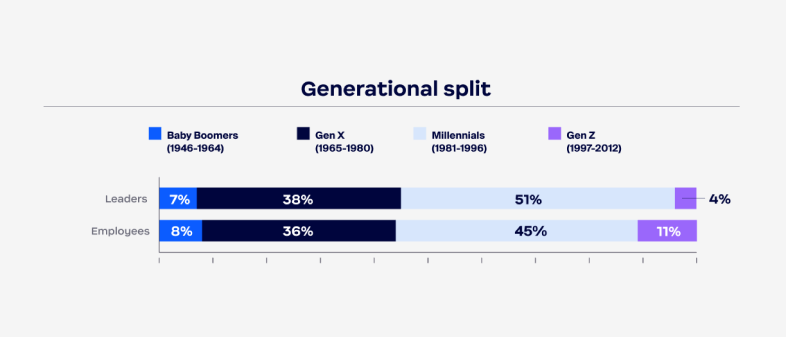

Interact with more than 10 people in a day
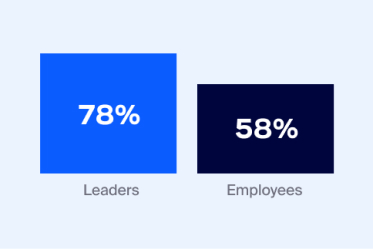
Interact with three or more teams in a day

Collaboration methods measured
Leaders and employees both reported similar challenges or barriers that made it difficult for them to collaborate.
83% of leaders and 77% of employees
82% of leaders and 81% of employees
82% of leaders and 72% of employees
These top outcomes were experienced by leaders and employees as a result of bad or ineffective collaboration:
32% of leaders and 41% of employees
32% of leaders and 33% of employees
28% of leaders and 34% of employees
The day-to-day activities of team leaders tend to involve more people and more cross-functional interaction than those of employees. Not surprisingly, leaders spend more time on collaboration and are more likely to experience related challenges.
While email, in-person meetings, and instant messaging/chat were the most common collaboration methods for leaders and employees, leaders were more likely to spend a significant amount of time on these.
Leaders were also more likely to say they spent more time than they wanted to on every type of collaboration method, with meetings (in-person and virtual) and email at the top.
Overall, leaders reported taking more time than employees to refocus when switching tasks. Leaders are most likely to say that it takes them between 10-15 min to refocus between tasks (39%), and another 30% said it takes them longer than 15 minutes to refocus. The majority of employees said it takes them less than 10 minutes to refocus (51%).
About one-third of team leaders spend one hour or more a day resolving collaboration challenges like:

Participating in meetings or chats with no clear outcome or that don’t solve a problem
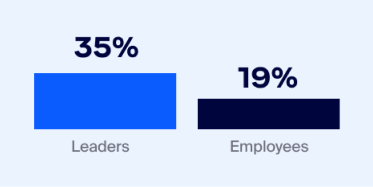
Resolving misunderstandings or miscommunications within their team
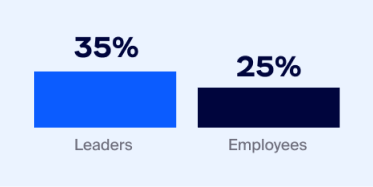
Catching up with tasks whose deadlines have already passed
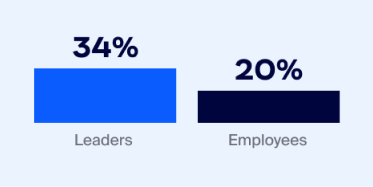
Following up with teammates to ask about the status of a project or task (34% vs 20% of employees)
Wasting just one hour on any of these tasks could cost organizations up to an estimated $16,491 a year per manager in inefficient productivity. When extrapolating that cost to an enterprise of 1,000 with 160 managers, assuming that one-third of leaders spend an hour on any one of these tasks, it could still add up to more than $874,000 annually in wasted time.*
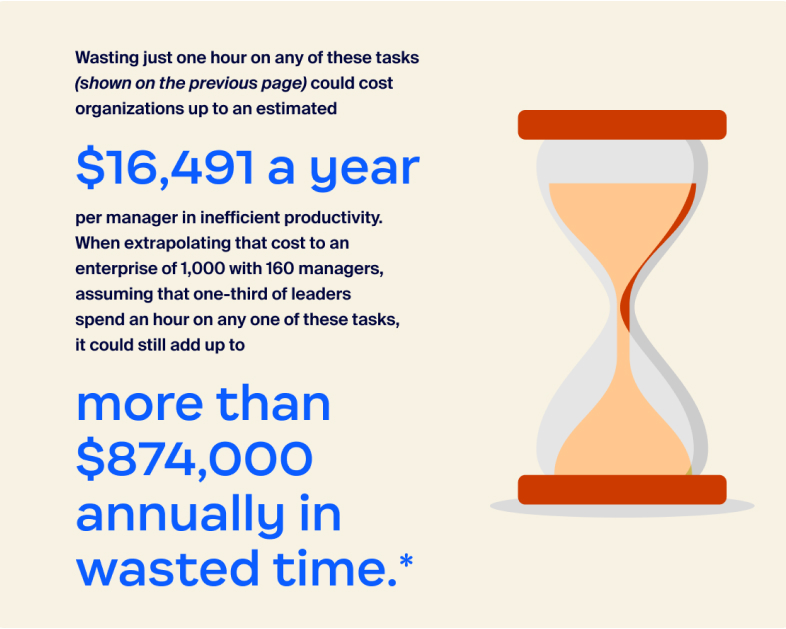
Gen Z leaders appeared to spend the most time resolving issues related to ineffective collaboration. Almost half (48%) of Gen Z leaders said they spend one or more hours a day following up with teammates to ask about the status of a project. This is much higher than older generations, especially Baby Boomer leaders.
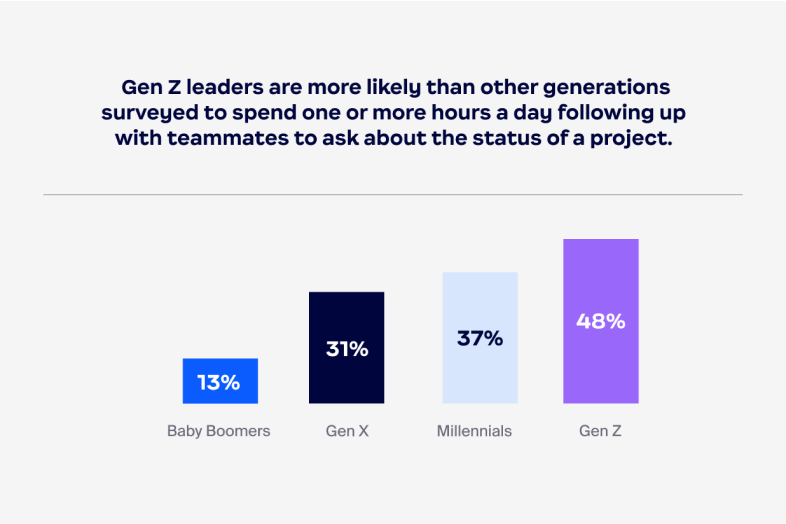
Takeaway: Team leaders already have a lot on their to-do lists. Time wasted refocusing between tasks or resolving issues related to ineffective collaboration could be better spent on more strategic initiatives or useful activities like developing better processes and workflows for their teams (43% of leaders said this is what they’d do with more time in their day).
Alleviating leaders’ collaboration challenges and reducing the significant amount of time spent on tasks like meetings and email should be a key priority for organizations. Consider how your organization can use AI and automation most effectively to help leaders spend their time in more impactful ways. Generative AI tools can save time by composing content and summarizing meeting points, thereby allowing people to be more selective about which meetings require in-person attendance and get caught up on meetings they choose not to attend. Automating follow-ups with direct reports or using AI to help compose simple follow-up messages can also help leaders free up more time in their schedules.
*Calculations per manager are an estimate based on average salary information for management occupations provided by the U.S. Bureau of Labor Statistics. Total cost is based on APQC data on average number of managers in an organization.
In-person meetings have always been a standard method of collaboration, and leaders and employees generally agree that their benefits include faster decision-making, better creativity, engagement, and connection with colleagues. However, instant messaging/chat was preferred among both leaders and employees.
Top three preferred collaboration methods
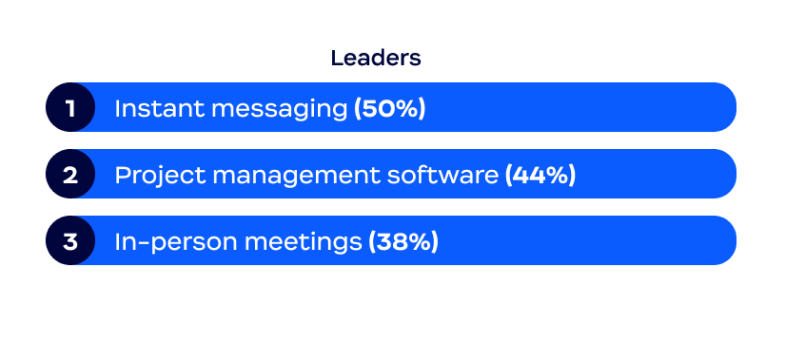
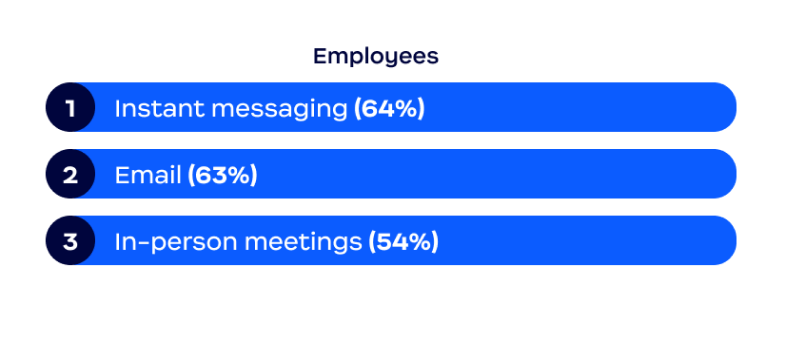
Even when considering different work styles, fully in-person, fully remote, and hybrid leaders all preferred instant messaging/chat as their top collaboration method. Project management software also ranked among the top three methods overall for each work style.
Digging deeper, generational differences revealed that Baby Boomer leaders strongly preferred in-person meetings. Gen X, Millennial, and Gen Z leaders were more likely to be varied in their preferences, leaning more toward non-face-to-face, asynchronous methods like project management software and instant messaging.

Gen X, Millennials, and Gen Z were also more varied in their beliefs about what tools are most effective, while Baby Boomer leaders were more consistent in their belief that in-person meetings had the most benefits. Gen Z leaders were least likely to see the benefits of in-person meetings, instead viewing instant messaging as having the greatest benefits on several fronts.
All generations agree that the benefits of in-person meetings include:
Instant messaging was identified by Gen Z, and in some cases, Gen X and Millennials, as being one of the preferred ways to collaborate and providing the following benefits:
Takeaway: Younger leaders’ perceptions about the benefits of collaboration methods beyond in-person meetings highlight the potential for using each collaboration method more intentionally. Organizations can leverage instant messaging/chat for quicker responses and more organized and efficient knowledge sharing, and consider how AI can help enhance the effectiveness of these tools.
Knowing that in-person meetings are beneficial for engagement, creativity, and connection, organizations should also explore how to help leaders and employees be more intentional with their in-person time. Hybrid employees should take advantage of their days in the office to schedule in-person meetings with colleagues. Workplace solutions like smart conference rooms and workspace reservation tools can help minimize friction when employees do go into the office so they can focus on optimizing their time in person. Additionally, organizations can look at how to improve the meeting experience for hybrid and remote colleagues so those in-person gatherings can be equally as effective for those joining virtually.
Some tension exists between the belief that in-person meetings are generally more beneficial, and people’s individual perceptions about how their time is best spent.
This may indicate that many leaders could be spending too much time in meetings that they feel are unproductive or unnecessary.
Additionally, too many meetings could contribute to two common issues identified by leaders and employees: difficulty finding time on others’ schedules to connect (83% of leaders and 77% of employees felt it was a challenge) and not having enough time in between meetings to get things done (82% of leaders and 72% of employees felt it was a challenge).
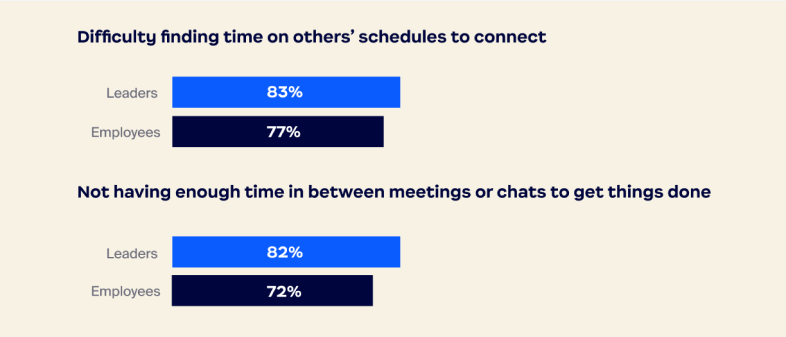
Leaders in Ireland spend more time in in-person meetings than any other country — 59% of leaders reported spending three or more hours a day meeting in person (24 percentage points higher than the leader average of 35%). However, 62% of Irish leaders say they spend more time in meetings than they want to, and as a whole, they did not view this type of collaboration as being the most effective for any of the measured benefits. Irish leaders were also more likely to report challenges to collaboration — 92% of them reported experiencing difficulty finding time on others’ schedules to connect and a lack of visibility into what teammates are working on.
On the other hand, 85% of Japanese leaders and 78% of Italian leaders spend two hours or less in meetings per day, and the majority of these groups (54% Japan, 57% Italy) said they spend just the right amount of time in them. They were also more likely to say their time spent was equally as productive or less productive if a meeting was canceled.
Takeaway: Excessive time spent in meetings that don’t achieve the intended goal could hinder collaboration efforts and lead to a cascading effect of challenges related to scheduling and time management. Leaders should focus on finding that “just right” amount of time for synchronous and/or in-person collaboration to avoid feelings of burnout or disengagement.
Leveraging other forms of asynchronous or non-face-to-face communication, such as instant messaging/chat, collaborative docs, whiteboard, and project management software, depending on the collaboration need, could help create a more balanced approach. Additionally, using these tools to better prepare for meetings (for example, collecting feedback in a collaborative doc beforehand) and taking action after meetings (following up on action items via instant messaging) may enable team members to use their face-to-face time more effectively.
Different apps and tools may promise greater productivity and time savings, but organizations should be cautious of app overload or introducing greater complexity into employees’ day-to-day workflows. As the number of tools and apps increases, so does the likelihood of experiencing challenges with collaboration.
Leaders who use more than 10 apps were up to 15 percentage points more likely than those who used fewer apps to experience consequences related to ineffective collaboration. More than one-third of leaders who use more than 10 apps reported experiencing these issues.
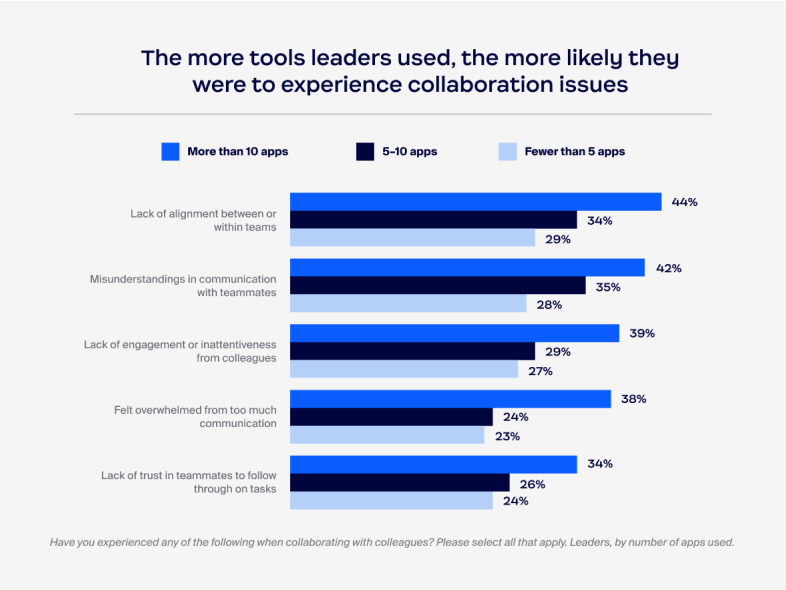
More apps were associated with more communication issues among employees, too — often to higher degrees than leaders. Notably, over half (54%) of those who use more than 10 apps have experienced a misunderstanding in communication, 20 percentage points higher than those who use fewer than five apps (34%).

Employees who use more than 10 apps spend more time than their peers resolving collaboration challenges. For example, 42% of employees who use more than 10 apps spend an hour or more following up with teammates to ask about the status of a project or task, 25 percentage points higher than those who use fewer than five apps (17%).
When employees and leaders need to switch tasks during the day, those who use more than 10 apps are also more likely to need more time to refocus. 42% of employees and 37% of leaders said it takes them 15 minutes or longer to refocus between tasks — which can quickly add up to an hour when switching tasks just four times in a day.
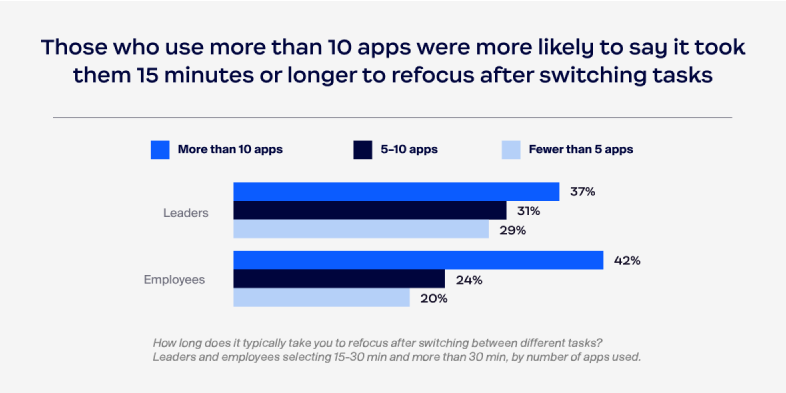
Takeaway: The data indicates that more apps used can contribute to greater collaboration challenges and more time spent resolving collaboration issues and refocusing. If your organization uses more than 10 apps, or even more than five apps, there’s a strong case to be made for reducing that number.
However, organizations still need to provide leaders and employees with the tools they need to do their best work — and earlier sections show how different methods of collaboration may be preferred by different age groups and countries. Consolidating to a single or handful of platforms that offer multiple tools, streamlined integrations, and different ways of collaborating could help address app burnout and context switching.
AI tools can help improve collaboration and address some of the barriers that teams spend their time on. Similar to what we found in our 2023 AI in the Workplace report, leaders are more likely to use AI than employees and are more bullish on its benefits.
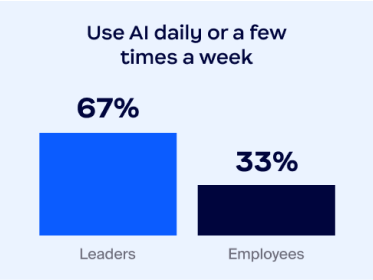
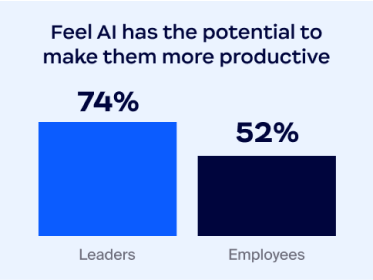
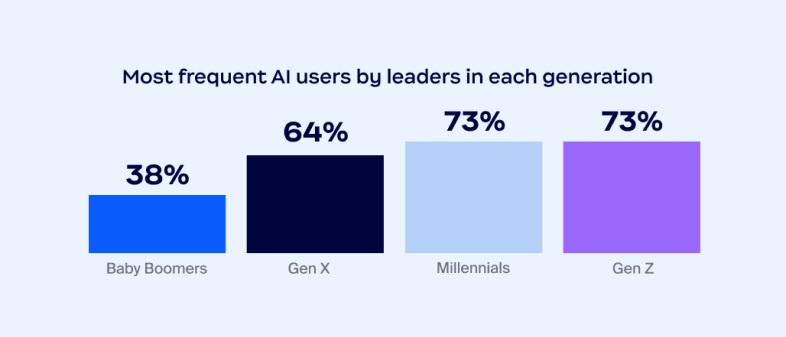
Leaders whose teams use AI in their roles reported favorable results from using AI. These results are higher than what was reported in our AI survey last year:
Leaders who use AI were more likely to see the benefits of asynchronous forms of collaboration such as collaborative shared documents, asynchronous brainstorming and ideation tools like whiteboards, and asynchronous video or audio messaging.

Leaders who use AI were also more likely than those who don’t use AI to find their criteria for productivity met always or often for the following methods of collaboration:
In terms of usage by country, leaders from the Netherlands and India were the heaviest users of AI. The majority (85%) of Dutch leaders and 80% of Indian leaders reported using it daily or a few times a week. Leaders from these countries are also likely to see the potential benefits of AI for collaboration more favorably than any other country.
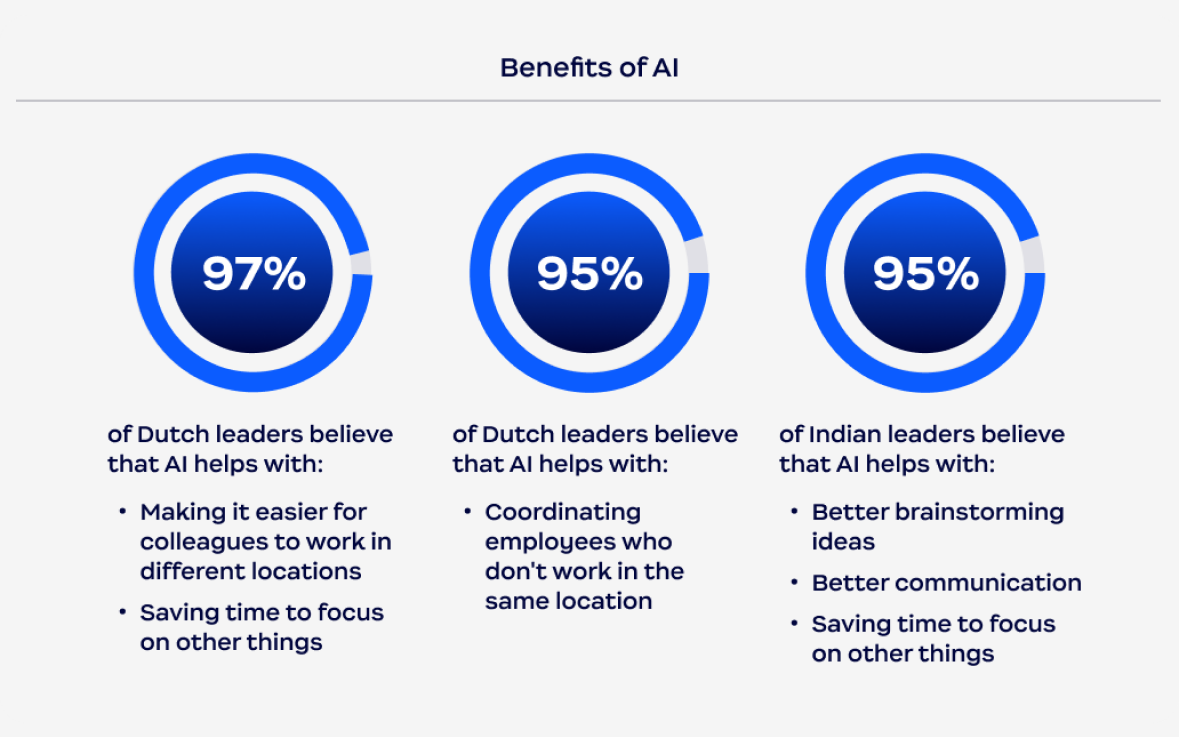
Employees in India also reported high usage of AI: 70% use it daily or a few times a week. The U.S. came in second for AI usage among employees with 40%, and Singapore and the United Arab Emirates came in third, with 37% reporting daily or near-daily usage.
Takeaway: More leaders are leaning into using AI, but not as many employees are taking that step by themselves — or they may not have employer-provided access to AI tools. Those who do use AI see favorable results and potential benefits, making it an important resource for enabling organizations to address challenges to collaboration and productivity and reduce time wasted. Leaders should focus on making AI tools more accessible to their entire workforce in a cost-effective way. They should also anticipate a learning curve for effective AI usage and provide training or resources to help employees use AI effectively, so they can realize its benefits more fully.
Meeting and app overload continue to create challenges for leaders and employees. This is nothing new, but the data indicates that these challenges can snowball, leading to further barriers and wasted time that results in a higher cost of bad collaboration for the organization. The true cost of bad collaboration is paid not just in the moment, but in the cumulative hours of ineffective meetings, refocusing between tasks, and resolving miscommunications.
On the other hand, a preference for instant messaging/chat and other types of asynchronous collaboration, especially among younger leaders, may indicate a shift in how we view collaboration. It’s not just about face-to-face connection — though that has clear benefits — but about looking at meetings as one stage in a collaboration lifecycle.
Here are a few considerations for improving collaboration in your workplace:
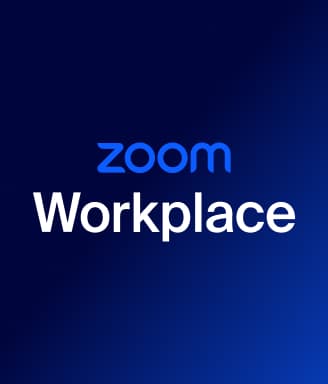
Zoom Workplace is an open collaboration platform with AI Companion that can help your organization streamline communication and reimagine how your teams work. See how our core communication and built-in productivity solutions, including meetings, team chat, shared docs, whiteboard, and more, work together to enable better collaboration no matter where employees are.